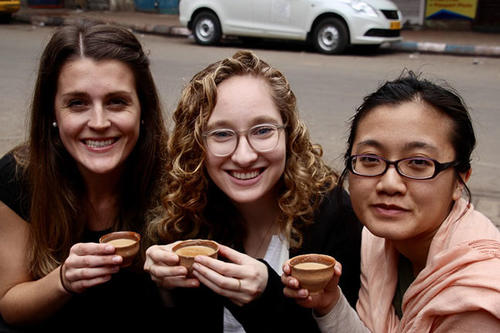
On a rainy morning this past January, Jeanne Moua, Zoe Kusinitz, and Hannah Currie—three U of M students in the master of public health program—sipped tea and nibbled cookies as they listened to the community health team at the Jan Seva Centre in Kolkata, India, describe their initiatives for the upcoming year.
Health team members told the U of M students they wanted to educate their community on a range of public health issues, including dental care, menstrual hygiene, cancer awareness, early marriage, safe touch, and self-defense for women.
Beth Virnig, the School of Public Health professor who created the Jan Seva field experience and who now oversees its implementation, says exposing students to conditions in the real world makes them better prepared to address current and future public health crises.
“Public health professionals who have had these immersive global experiences are able to help in … global crises because they are able to put themselves in people’s shoes without judgment, and to then help them use information to make decisions that keep them and their families healthy,” Virnig says.
I think it was a practice in empathy and discomfort.
As they settled into their routines in Kolkata and at Jan Seva, the SPH graduate students each volunteered to work on different initiatives that aligned with their experiences and interest.
Moua, who is studying epidemiology at the U of M and has done field work in Thailand and Laos, offered to run spreadsheets and research initiatives aimed at raising cancer awareness. In that research, she learned that residents who agreed to even one cancer screening— which the school had previously provided—were more likely to agree to additional screenings in the future.
She also researched first aid for burns, because the standard advice—to place the burned area under cold running water—doesn’t work for the majority of Jan Seva families since they don’t have plumbing.
Currie capitalized on her past experience working at a tuberculosis clinic to create a low-literacy screening tool that the community health workers could use when they were meeting with families. (India has a comprehensive plan to eliminate tuberculosis by 2025.)
She says she was careful to present her findings as questions, not solutions. “I’m a student, not a professional,” she says. “But often our opinions as Westerners are taken as fact. That’s an ethical issue that comes up when it comes to global volunteer and mission work.”
Kusinitz, who spent an undergraduate semester in Copenhagen studying gender and sexuality, focused her work on menstrual health and hygiene. She learned that tampons are not widely used in the area because of a cultural belief that they compromise virginity, and that while the community health team wanted to encourage mothers to use menstrual pads, most Jan Seva mothers use rags, which they clean at the community taps and then dry inside their home.
“I think it was a practice in empathy and discomfort,” says Kusinitz about her stay. “It was an opportunity to be uncomfortable and out of your element and to find connections and commonality, to learn from people whose experiences are so different from your own. I got to experience what it was like to feel like there was nothing I could do to help. And to then figure out what to do anyway.”
- Categories:
- Health




